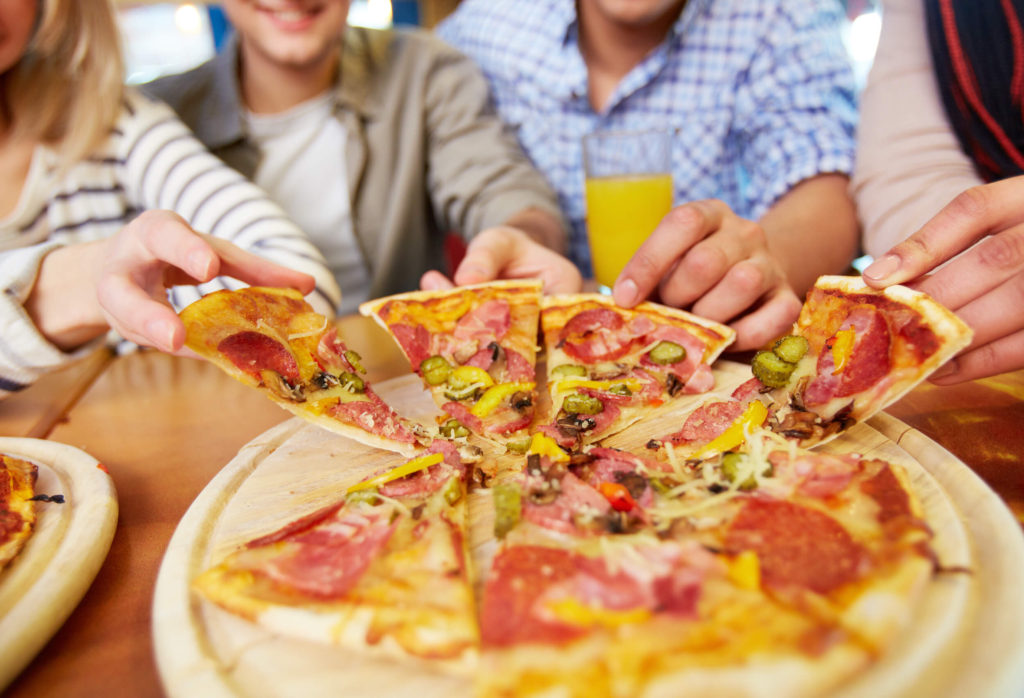By Kevin Jones
It’s no secret that the U.S. is one of the most overweight countries in the world. With 34.3 percent of the population considered obese according to the body mass index (BMI), you have to wonder how we got to this point. Especially when you consider that 50 years ago, only 13.4 percent of Americans were obese.
How We’ve Eaten Over The Years
If you guessed that as a culture we used to eat a lot better than we do now, you would be right on the mark. Exactly 50 years ago in 1967, the American diet was both lower in calories overall and sugar/fat consumption.

1967 diet breakdown:
Sugar/fat – 31 percent (928 calories a day)
Grains – 21 percent (615 calories a day)
Dairy/eggs – 20 percent (608 calories a day)
Meat – 13 percent (399 calories a day)
Produce 8 percent (237 calories a day)
Other 6 percent (191 calories a day)
Overall Calorie Intake – 2,978 calories a day
1977 diet breakdown:
Sugar/fat – 35 percent (1,083 calories a day)
Grains – 20 percent (623 calories a day)
Dairy/eggs – 17 percent (536 calories a day)
Meat – 13 percent (411 calories a day)
Produce 8 percent (257 calories a day)
Other 7 percent (226 calories a day)
Overall Calorie Intake – 3,136 calories a day
1987 diet breakdown:
Sugar/fat – 34 percent (1,172 calories a day)
Grains – 22 percent (742 calories a day)
Dairy/eggs – 16 percent (566 calories a day)
Meat – 13 percent (433 calories a day)
Produce 8 percent (293 calories a day)
Other 7 percent (242 calories a day)
Overall Calorie Intake – 3,448 calories a day
1997 breakdown:
Sugar/fat – 34 percent (1,254 calories a day)
Grains – 24 percent (871 calories a day)
Dairy/eggs – 14 percent (524 calories a day)
Meat – 12 percent (455 calories a day)
Produce 8 percent (308 calories a day)
Other 6 percent (235 calories a day)
Overall Calorie Intake – 3,647 calories a day
2007 diet breakdown:
Sugar/fat – 36 percent (1,340 calories a day)
Grains – 22 percent (828 calories a day)
Dairy/eggs – 14 percent (538 calories a day)
Meat – 13 percent (501 calories a day)
Produce 8 percent (292 calories a day)
Other 7 percent (272 calories a day)
Overall Calorie Intake – 3,771 calories a day

Note that while sometimes the percentage will remain the same, the caloric density is different. This can be attributed to losing nutrient density in our food while caloric value fluctuates.
What Americans Are Eating Now
Let’s put some of those numbers into perspective. With a steady increase in calorie intake, 72.9 percent of the overall American population ranges from overweight to extremely obese. Last report in 2008 ranked the U.S. as the 18th fattest country in the world.
Now the overall American diet breakdown looks like this:
Sugar/fat – 37 percent (1,342 calories a day)
Grains – 22 percent (799 calories a day)
Dairy/eggs – 14 percent (527 calories a day)
Meat – 13 percent (469 calories a day)
Produce 8 percent (279 calories a day)
Other 6 percent (225 calories a day)
Overall Calorie Intake – 3,641 calories a day
How To Fix Our Eating Habits
One way to address the appalling changes in the American diet is to understand just how many calories you should be taking in. While an often-repeated standard is 2,000 for women and 2,500 for men, it is not actually that simple. For one thing, that rule is based on the idea that the woman is 126 lbs and 5’4” and the man is 154 lbs and 5’10”, with both living moderate to active lifestyles.
As the average American has gotten steadily more sedentary, these high numbers need to be cut down and dealt with on a person-to-person basis. Some ways to combat the obesity crisis and eat better are:
Calculate intake – Don’t worry, you don’t have to use some crazy equation. There are many good calories calculators that can help you figure out how many calories you should be taking in daily, depending on your current weight, height, and activity level.
Change habits – Maybe you need a more drastic change and want to try intermittent fasting (IF). Part of the overeating issue is that we tend to eat when bored, snacking mindlessly. When practicing IF, you set up a period of time where you can eat as you normally would, but outside of that time, you don’t eat anything.
Add produce – A clear trend since 1967 is that we are not eating enough produce. If over half the American diet is sugar/fats and grains with only 8 percent reserved for produce, we’re doing wrong. Start judging your meals: are they colorful, minimal processing, and mostly from natural sources? If that’s not the case, then re-evaluate what you’re eating.
We didn’t have everything right 50 years ago, but we can definitely improve our eating habits to at least match what the previous generation did do right.
ABOUT THE AUTHOR:
Kevin Jones is a health and fitness blogger and a regular contributor to a number of fitness websites. He writes for NordicTrack. During his free time, he likes to be very active and spend time with his wife and two children shredding the slopes of Park City, Utah, or chasing down the Salt Lake City Korean food trucks. Connect with him online: LinkedIn– Twitter
Resources:
What the World Eats: http://www.nationalgeographic.com/what-the-world-eats/
29 Most Obese Countries In The World: http://www.worldatlas.com/articles/29-most-obese-countries-in-the-world.html
Prevalence of overweight, obesity and extreme obesity among adults: United States, trends 1960-62 through 2005-2006: https://www.cdc.gov/nchs/data/hestat/overweight/overweight_adult.htm
Country Comparison: Obesity – Adult Prevalence Rate: https://www.cia.gov/library/publications/the-world-factbook/rankorder/2228rank.html
S. Adult Obesity Rates Since 1960: https://infogr.am/US-Adult-Obesity-Rates–Since-1960
The Fat Burning, Brain Boosting Benefits Of Intermittent Fasting: https://www.projectwellnessnow.com/the-fat-burning-brain-boosting-benefits-of-intermittent-fasting/
Estimated Calorie Needs per Day by Age, Gender, and Physical Activity Level: https://www.cnpp.usda.gov/sites/default/files/usda_food_patterns/EstimatedCalorieNeedsPerDay
YOU MAY ALSO LIKE:
HOW TO USE BREATHING TECHNIQUES TO IMPROVE YOUR RUN
By Kevin Jones There are so many benefits to running, from better cardiovascular health to improved brain health. But if you…
SPORTS DRINKS MAY BE LINKED TO CHILDHOOD OBESITY RATES
By Kevin Jones A few years ago, I resolved to always include something in my holiday shopping list that would help…
WHY WE NEED IODINE IN OUR DIET
According to WebMD, since the early 70s changes in Americans’ diet have led to decreasing intake of iodine. We need iodine…
ASHWAGANDHA – A POWERFUL ADAPTOGEN
Ashwagandha is a powerful adaptogenic herb employed in western Ayurvedic medicine to restore balance, strengthen the immune system, and aid well-being….
“A QUEEN BEE IN TRAINING…”
In 2010, Maryam Henein’s 15-year career as an investigative journalist, entrepreneur, and producer hit a milestone with the release of her…
DIY FRANKINCENSE ROSE CREAM
Make this easy DIY frankincense rose face cream with all organic, natural ingredients. Your new, well-nourished skin will thank you! INGREDIENTS:…








